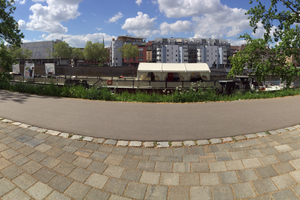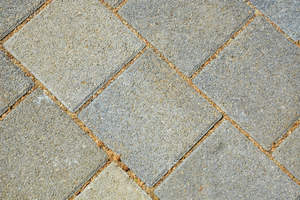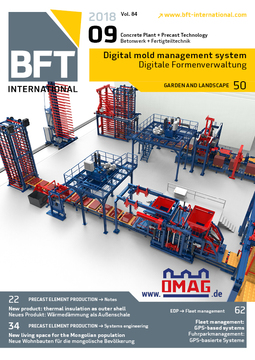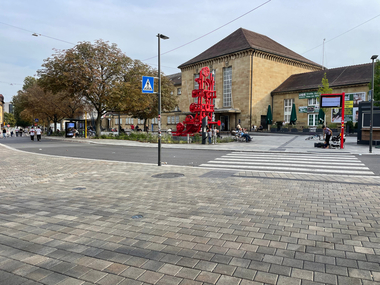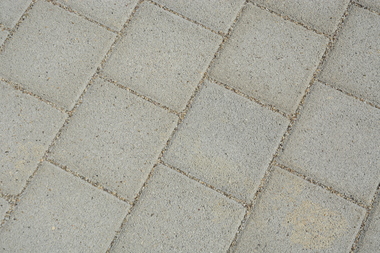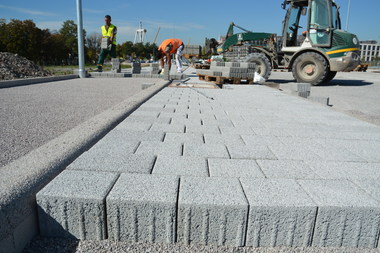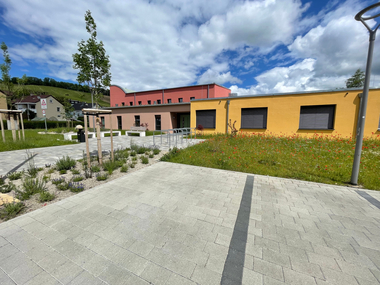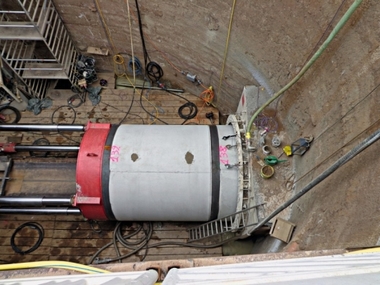„Neckar – area to experience“ relies on permeable pavers
The Swabian metropolitan city of Stuttgart was originally located on the Nesenbach, a small creek that has been covered almost completely in the meantime. The city got its largest and oldest district by the merger with Cannstatt in 1905, hence it came closer to the Neckar river. The river has always characterized the landscape both in terms of the area and the culture. Commercially used properties, streets, and industrial facilities reach up to the water in many areas, so that the river banks of the Neckar are not open to the public there. The areal structure mainly used for commercial and infrastructure purposes, over many years, has led to the fact that people in Stuttgart had little interest in the river for a long time.
However, new needs and the demand on what urban space should provide arises owing to a changing urban society with changed everyday and leisure behavior. With the master plan „Neckar – area to experience“, the responsible authorities of the city now try to make Stuttgart again a city on the river which can be experienced. Some projects, such as landing stages for river cruise ships and a Wasen crossing, shall be completed until 2022. A small measure that has already been realized is the redesign of a green area next to the Mühlgrün parking garage. Planners relied on the Stuttgart permeable pavers as pavement here.
Recapturing the Neckar
Too dark, too dirty, and not ideally located – these are the statements of Cannstatt citizens when judging the Mühlgrün parking garage built in 1988 and located directly on the Neckar. Although it is only a few steps away from the historic center of Cannstatt, it seems as if the parking garage on the Neckar never really reached people‘s awareness. However, members of the Cannstatt district council have assumed for a long time that the unattractive surroundings are another reason. Axel Mundsinger of Mundsinger + Hans landscape architects based in Ostfildern describes the situation: „The area has made a sad impression for a long time. Beaten paths, sparse grass, and lack of sojourn quality do not create an inviting impression.“
Therefore, the responsible parties decided to turn the area once again into a place with a welcoming character. It was planned to restructure the place using money from the urban development allowance. Mundsinger stated: „The area was to be redesigned with the aid of an appropriate pavement so that the existing plane trees stay in place and the root areas are sealed as little as possible. It was also planned to provide seating facilities beneath the trees extending via a central stairway down to the Neckar embankment as well as a new barrier-free entrance to the parking garage.“
Specified values fulfilled
The planners decided to use the so-called Stuttgart permeable pavers made by Adolf Blatt, the concrete factory based in Kirchheim am Neckar, for paving the place covering an area of about 600 m². Mundsinger commented: „As the name already suggests, this concrete block system originates from the city of Stuttgart. As we have used the system already for some other projects in the surroundings with success, it also was the preferred choice for this project. The advantage of this system is the combination of two particular properties. For one thing, the block is made of porous concrete, thus easily fulfilling the values specified by the city of Stuttgart regarding the water permeability of such areas,“ said Mundsinger. For the respective verification Blatt conducted an infiltrometer test. The measurements carried out at an area newly paved with Stuttgart permeable pavers revealed a rainwater infiltration of 7,100 l/(s x ha) rainfall when using 1 to 3 mm chippings for filling the joints.
Hence, the specified infiltration rates for permeable pavements according to the DWA worksheet A 138 (2002) and the respective FGSV code of practice of at least 270 l(s x ha) when newly installed are exceeded by far, which means that a surface runoff will be ensured even at an event of heavy rainfall.
Attractive colors and shapes
The second advantage of the paver system are the visual properties. Despite the water permeability, the Stuttgart permeable pavers have a fine-grain surface structure and are provided in an attractive variety of colors and shapes, thus also meeting every aesthetic requirements simultaneously. „In order to provide the area of the place with a more pleasant appearance and to integrate the plane trees, we have decided to use a paving block surface with alternating shades in anthracite, yellow and grey. The slightly changing play of colors creates a certain warm character and does not appear as cold as a grey material,“ Axel Mundsinger said.
Now the place next to the Mühlgrün parking garage has been redesigned since the end of 2017. The new design of the area and the barrier-free entrance to the parking garage contribute to the fact that the overall area has reached the awareness of the Cannstatt citizens once again. Thanks to the master plan „Neckar – area to experience“ several other projects will be implemented along the Neckar bank until 2035.

